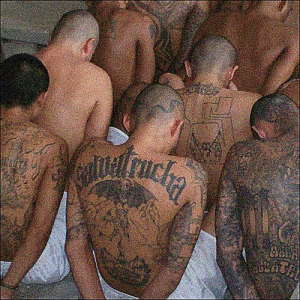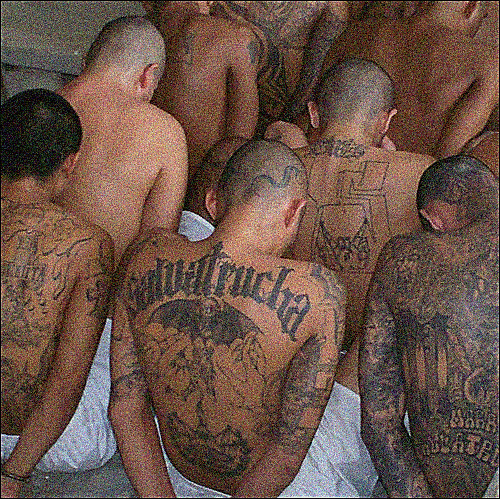 The most significant story in Central America right now is also the most underreported. El Salvador, the tiniest country in the land belt connecting North and South America, has long suffered socioeconomic violence—first in its civil war during the 1980s, then in the period of organized crime’s rising power in the 1990s, and most recently under the mano dura years of conservative authoritarianism—largely in answer to the growing influence of transnational criminal gangs in the 2000s. But since the start of May, El Salvador’s murder rate—by some estimates, the highest in the world in 2011—has dropped by nearly 66 percent, the result of a truce between the country’s two leading gangs (or maras, as they are popularly known) that was brokered in March by religious and government representatives and deepened by gang leaders on May 2.
The most significant story in Central America right now is also the most underreported. El Salvador, the tiniest country in the land belt connecting North and South America, has long suffered socioeconomic violence—first in its civil war during the 1980s, then in the period of organized crime’s rising power in the 1990s, and most recently under the mano dura years of conservative authoritarianism—largely in answer to the growing influence of transnational criminal gangs in the 2000s. But since the start of May, El Salvador’s murder rate—by some estimates, the highest in the world in 2011—has dropped by nearly 66 percent, the result of a truce between the country’s two leading gangs (or maras, as they are popularly known) that was brokered in March by religious and government representatives and deepened by gang leaders on May 2.
Mara Salvatrucha (MS-13) and its rival, MS-18, were formed on the streets of South Central Los Angeles by young refugees of the Central American wars of the 1980s and 90s. Largely comprising Honduran and Salvadoran youths, the gangs initially provided protection to Latinos excluded from Mexican gangs, and the largely African-American Bloods and Crips. The maras blossomed, growing in scope and capacity to carry out sophisticated operations. Before long, the maras appeared on the FBI’s radar and in 1996, changes in the immigration law allowed the FBI to deport tens of thousands of suspected mareros back to their native countries. Not surprisingly, back home and without ready access to formal market opportunity, they set up shop and continued their business as usual. Since then, the gangs have grown so strong that they are virtually uncontrollable in Central America, and have become worrisome threats to the security of the United States. The truce between the maras, then, comes as a welcome relief on all sides.
And the good news extends beyond declining rates of violence and symbolic “days without murder.” As the Economist reports, “The mobs have since made further concessions. On May 2nd they promised not to recruit in schools. Five days later inmates at La Esperanza, an overcrowded prison, vowed to stop extorting people using jail phones. ‘I want to ask forgiveness from society and those who gave us the chance to change,” said Dionisio Arístides, the Salvatrucha leader. “We’re human beings who aren’t just here to do evil.’”
This is not to say that the truce between rival gangs will hold up in the long term. Many, as the Economist coverage suggests, are suspicious that the maras will be peaceful long enough to allow El Salvador’s economy recover from the damage it has suffered as the gangs duke it out for monopoly control over territory, extortion rackets, and trafficking networks. But a bigger concern lies in the worry that the gangs have grown so big and unwieldy that even if the higher ups in MS-13 and MS-18, many of whom are directing traffic from prison, genuinely endorse the peace plan, they may not be able to effectively enforce it.
Nor is it to suggest that government security forces have given up their old ways. In some respects, the spirit of mano dura—the heavily militarized approach to combating maras under former president, Tony Saca—is alive and well. When leftist president Mauricio Funes announced earlier this year that his government intended to implement a nationwide curfew and beef up school security by calling in the military to stand guard, Insight Crime noted that these policies “appear to be part of Funes’ escalation of the war against street gangs…Funes is mimicking the…strategy of his predecessors, placing ex-military officials in top security posts, some of whom are intimating that they may begin mass incarcerations of suspected gang members. These policies have more than a few critics. El Salvador’s focus on incarcerating suspected gang members has placed more inmates in badly overcrowded prisons… These overcrowded prisons may have worsened crime and violence in the country.”
Nevertheless, things in El Salvador right now look markedly more hopeful than they have in decades. Any substantial reduction of violence is obviously to be embraced, as are efforts that the Funes administration has made to match iron-fist policies by extending an open hand to former criminals seeking social reintegration. Perhaps most encouragingly, gang members from opposing factions have begun to collaborate on music projects and other forms of cultural production which may have positive normative effects—both within the gangs and more broadly in Salvadoran society—and which seem like an awfully elaborate, and unlikely, PR ruse if the maras weren’t serious about giving peace a chance.
Still, any optimism on this count must be met with a heavy dose of caution.

